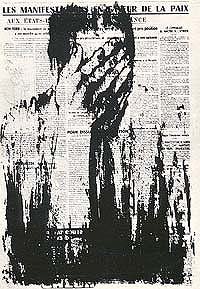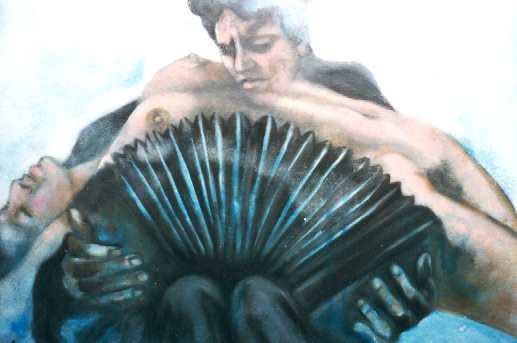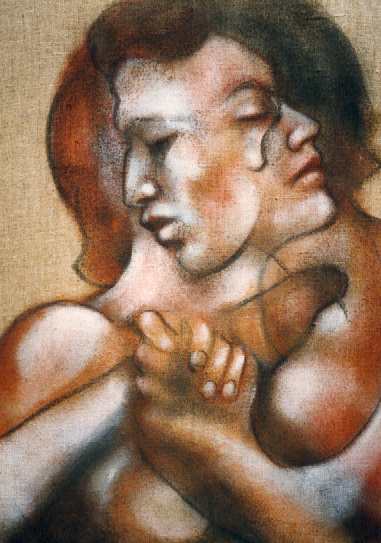
BIOGRAPHY
MARIA AMARAL
Exiled from Spain in 1949 after years spent resisting
Francoís regime, her pastor father and teacher mother found refuge in Argentina.
On Christmas Day the following year in Buenos Aires, Maria Amaral was born.
In 1967, it was her turn to experience exile when she and her family were forced to flee from Argentina.
France welcomed them and they settled in Strasbourg,
before she left for Paris and the Ecole des Beaux-Arts,
where she earned an honours degree in fine art, setting up her future as an artist.
German expressionism, Munch, Van Gogh, Picassoís blue period
and above all, Käther Kollwitz and the great Latin American painters such as Guayasamin,
Siqueiros, Rivera, Carpani and Lam were her primary sources of inspiration regarding techniques
and self-expression. She steered clear of the aesthetic movement of the seventies and being more
concerned with the harsh realities of peopleís daily lives, she centred her work around the soul
of Latin America: its roots, its racial mix and its suffering.

Her early works in black and white had a common, barely perceptible
breath-like quality in their lines. Her lines were made with hard charcoal,
the medium through which Maria Amaral chose to express herself for more than twenty years.
She quickly mastered drawing, etching, lithography and poster design in order to use them as
tools, not just to denounce, but to proclaim the presence of the often scorned individual
living in an endless exile.

Seeing her drawings for the first time transports you to a visual exile from which
there is no return. Of course, you notice the contrasts between black and white, shade and light,
life and death; but beyond this basic, Manichaean aspect of her work is pain, transfigured not
by its cruelty, but by its very modesty, its silence, even its exactitude, which,
once the initial disturbance has passed, we find somewhat comforting. By this I mean that the
suffering and cruelty are neither isolated nor pushed faraway. This is what elevates her work:
these faces, eyes, folds, hands are close enough for us to recognise ourselves in them.

The eighties saw a surprising change, as work in colour began to appear alongside her familiar
black and white. Love, marriage, motherhood are all possible explanations for this.
Then came still life, the meeting of Europe and Latin America, the tango, the bullfight,
loving bodies and a whole array of portraits. She began to paint as she loved, both generous
and confident; pain had to be cured; she laboured without respite. With a lack of artifice,
she made use of every possible painting technique. But always as a means, never an end.
A thistle suffering the summer furnace is given a final burst of life by the artist before it
dries up and dies. In a field of sunflowers she chooses to capture the final blast of colour,
the last moment of splendour of the flower, about to succumb wilted and twisted to the searing
heat.
More than the mere horror of the bullfight, she depicts the union between man
and beast, as equal partners in a dizzying spectacle, both dancing to the rhythm of fear,
intertwined before the crucial final act. She sets out to capture man in the instant before
his crime, at the moment where his weakness and mystery are at their highest. Maria Amaral
strips the bullfight totally bare, almost to the point where there is no bull, no matador,
no arena - even the sunshine is indiscernible. The colours follow the rhythm of her heart;
her lines are guided by a rising vibrato; and the instant before death is frozen before our
very eyes. This is neither the time to try to understand, nor to weigh up the pros and the cons.
No, this is a moment of revelation, truth is unveiled, wind and time have stopped, the sun has
fizzled out and breath itself has ceased. This is life, our life, dancing and burning before us
on the canvass that mirrors our soul. Eso es Arte!
With the tango series, Maria Amaral turns her back on the commonly held
preconceptions of nostalgia and melancholy, which weigh down the dance and its culture.
Her tango is light, sensual and amusing. Where we usually see lament, hopelessness and
gloom, she injects blue, full heaving bosoms, generous buttocks, flesh, and joie de vivre.
Maria Amaralís tango is the real thing, in that it effects us deeply without resorting to
sentimentality. It twists and turns, intermingles and tangles to produce a closer
gotàn, -a touch- a joining together; in the same way that hands playing
the dislocated bandoneón finally meet again and take hold of loving bodies.

Loving bodies. Here, Maria Amaral can no longer hold back her generosity,
her tenderness and her affection. A body is more than just a body, itís a profusion of bodies,
spreading out, invading the canvass, the drawing and the space. She loves the human body to
such an extent she divides it, mixes it up, kneads it, and dislocates it so that we may admire
its many parts, its many surprises. Two bodies intertwine with a flurry of caresses, a wave of
tenderness. Time has flown, replaced by love.

These time-devoured faces, craggy beyond suffering, are those of our own soiled humanity,
both ravaged and enlightened, resistant and generous. Maria Amaral does not simply draw portraits
, she gathers up faces, gives them a haven, keeps them and honours them.
She can rarely keep hands out of her portraits. For Maria Amaral, hands have faces, too.
This is her way of saying that we are what we do. For her, hands are the true windows of the
soul.
With naked honesty, precision and detail, her line reconstitutes the real presence of each
person: an homage to their humanity, not their identity. Raping an expression to death and
oblivion while using it to create a mirror for the living; this is what Maria Amaral does and
it is simply beautiful.
In these bodies and portraits, in this generous, confident love, exile has been exorcised,
given some kind of meaning, some kind of life, by Maria Amaral.

JPE: www.chez.com/lepoweb